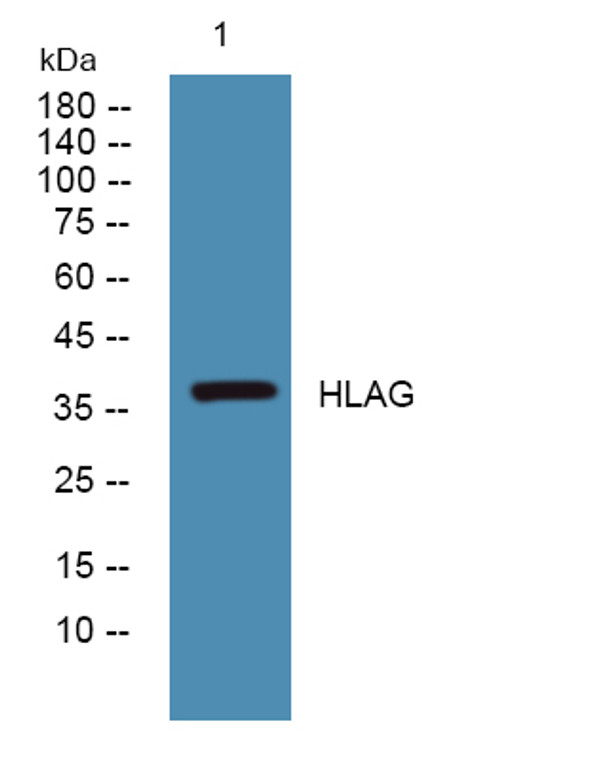| Host: |
Rabbit |
| Applications: |
WB/ELISA |
| Reactivity: |
Human |
| Note: |
STRICTLY FOR FURTHER SCIENTIFIC RESEARCH USE ONLY (RUO). MUST NOT TO BE USED IN DIAGNOSTIC OR THERAPEUTIC APPLICATIONS. |
| Short Description: |
Rabbit polyclonal antibody anti-HLA class I histocompatibility antigen, alpha chain G is suitable for use in Western Blot and ELISA research applications. |
| Clonality: |
Polyclonal |
| Conjugation: |
Unconjugated |
| Isotype: |
IgG |
| Formulation: |
Liquid in PBS containing 50% Glycerol and 0.02% Sodium Azide. |
| Purification: |
The antibody was affinity-purified from rabbit antiserum by affinity-chromatography using epitope-specific immunogen. |
| Concentration: |
1 mg/mL |
| Dilution Range: |
WB 1:500-2000ELISA 1:5000-20000 |
| Storage Instruction: |
Store at-20°C for up to 1 year from the date of receipt, and avoid repeat freeze-thaw cycles. |
| Gene Symbol: |
HLA-G |
| Gene ID: |
3135 |
| Uniprot ID: |
HLAG_HUMAN |
| Specificity: |
HLAG Polyclonal Antibody detects endogenous levels of protein. |
| Immunogen: |
Synthesized peptide derived from part of the human protein |
| Post Translational Modifications | N-glycosylated. Soluble HLA class I histocompatibility antigen, alpha chain G: Produced by proteolytic cleavage at the cell surface (shedding) by matrix metalloproteinase MMP2. |
| Function | Isoform 1: Non-classical major histocompatibility class Ib molecule involved in immune regulatory processes at the maternal-fetal interface. In complex with B2M/beta-2 microglobulin binds a limited repertoire of nonamer self-peptides derived from intracellular proteins including histones and ribosomal proteins. Peptide-bound HLA-G-B2M complex acts as a ligand for inhibitory/activating KIR2DL4, LILRB1 and LILRB2 receptors on uterine immune cells to promote fetal development while maintaining maternal-fetal tolerance. Upon interaction with KIR2DL4 and LILRB1 receptors on decidual NK cells, it triggers NK cell senescence-associated secretory phenotype as a molecular switch to promote vascular remodeling and fetal growth in early pregnancy. Through interaction with KIR2DL4 receptor on decidual macrophages induces pro-inflammatory cytokine production mainly associated with tissue remodeling. Through interaction with LILRB2 receptor triggers differentiation of type 1 regulatory T cells and myeloid-derived suppressor cells, both of which actively maintain maternal-fetal tolerance. May play a role in balancing tolerance and antiviral-immunity at maternal-fetal interface by keeping in check the effector functions of NK, CD8+ T cells and B cells. Reprograms B cells toward an immune suppressive phenotype via LILRB1. May induce immune activation/suppression via intercellular membrane transfer (trogocytosis), likely enabling interaction with KIR2DL4, which resides mostly in endosomes. Through interaction with the inhibitory receptor CD160 on endothelial cells may control angiogenesis in immune privileged sites. Isoform 2: Likely does not bind B2M and presents peptides. Negatively regulates NK cell- and CD8+ T cell-mediated cytotoxicity. Isoform 3: Likely does not bind B2M and presents peptides. Negatively regulates NK cell- and CD8+ T cell-mediated cytotoxicity. Isoform 4: Likely does not bind B2M and presents peptides. Negatively regulates NK cell- and CD8+ T cell-mediated cytotoxicity. Isoform 5: Non-classical major histocompatibility class Ib molecule involved in immune regulatory processes at the maternal-fetal interface. In complex with B2M/beta-2 microglobulin binds a limited repertoire of nonamer self-peptides derived from intracellular proteins including histones and ribosomal proteins. Peptide-bound HLA-G-B2M complex acts as a ligand for inhibitory/activating KIR2DL4, LILRB1 and LILRB2 receptors on uterine immune cells to promote fetal development while maintaining maternal-fetal tolerance. Upon interaction with KIR2DL4 and LILRB1 receptors on decidual NK cells, it triggers NK cell senescence-associated secretory phenotype as a molecular switch to promote vascular remodeling and fetal growth in early pregnancy. Through interaction with KIR2DL4 receptor on decidual macrophages induces pro-inflammatory cytokine production mainly associated with tissue remodeling. Through interaction with LILRB2 receptor triggers differentiation of type 1 regulatory T cells and myeloid-derived suppressor cells, both of which actively maintain maternal-fetal tolerance. Reprograms B cells toward an immune suppressive phenotype via LILRB1. Isoform 6: Likely does not bind B2M and presents peptides. Isoform 7: Likely does not bind B2M and presents peptides. |
| Protein Name | Hla Class I Histocompatibility Antigen - Alpha Chain GHla G AntigenMhc Class I Antigen G Cleaved Into - Soluble Hla Class I Histocompatibility Antigen - Alpha Chain GShla-G |
| Database Links | Reactome: R-HSA-1236974Reactome: R-HSA-1236977Reactome: R-HSA-198933Reactome: R-HSA-877300Reactome: R-HSA-909733Reactome: R-HSA-9705671Reactome: R-HSA-983170 |
| Cellular Localisation | Isoform 1: Cell MembraneSingle-Pass Type I Membrane ProteinEndoplasmic Reticulum MembraneEarly Endosome MembraneSoluble Hla Class I Histocompatibility AntigenAlpha Chain G: SecretedIsoform 2: Cell MembraneIsoform 3: Cell MembraneIsoform 4: Cell MembraneIsoform 5: SecretedEarly EndosomeIsoform 6: SecretedIsoform 7: SecretedCell ProjectionFilopodium MembraneHla-G Trogocytosis From Extravillous Trophoblast's Filopodia Occurs In The Majority Of Decidual Nk Cells |
| Alternative Antibody Names | Anti-Hla Class I Histocompatibility Antigen - Alpha Chain G antibodyAnti-Hla G Antigen antibodyAnti-Mhc Class I Antigen G Cleaved Into - Soluble Hla Class I Histocompatibility Antigen - Alpha Chain G antibodyAnti-Shla-G antibodyAnti-HLA-G antibodyAnti-HLA-6.0 antibodyAnti-HLAG antibody |
Information sourced from Uniprot.org
12 months for antibodies. 6 months for ELISA Kits. Please see website T&Cs for further guidance







